The fast-growing ornamental sweet potato vine is easy to care for and a popular choice as a pot filler and ground cover.
It’s a vigorous grower with interesting colors and leaf shapes. These versatile plants are equally at home in hanging baskets or a garden bed.
With the correct care, even a beginner can learn to grow it easily.
Use our sweet potato vine care guide to find out about the light, water, soil, and fertilizer requirements of this beginner-friendly plant. And get info on common pests and fixing problems, too.

Quick Sweet Potato Vine Plant Care Overview
| Scientific name: | Ipomoea batatas |
| Classification: | Tropical plant |
| Common names: | Sweet Potato Vine, Ornamental Sweet Potato |
| Hardiness: | Zones 9-11 |
| Temperature: | 50-95°F (10-35°C) |
| Flowers: | Lavender, blooms late summer-early fall |
| Light: | Full sun to part shade outdoors, bright light indoors |
| Water: | Keep soil evenly moist, do not overwater |
| Humidity: | Average to high |
| Fertilizer: | General purpose plant food in spring |
| Soil: | Well-draining, fertile soil |
| Common pests: | Beetles, caterpillars, aphids, weevils, whiteflies |
Information About Ornamental Sweet Potato Vines
The ornamental sweet potato plant (Ipomoea batatas) is a tropical, fast-growing perennial vine native to Central and South America.
Many people plant sweet potato vine for its abundant, colorful foliage, often as ground cover or filler for containers. You can let the vines mound or trail, or you can train them to climb.
They grow up to 6’ or more in the right environment. Colors vary widely, including chartreuse, yellow, burgundy, green, bronze, dark purple, and black. You can even get a variegated or tricolor sweet potato vine.
While it is related to the sweet potatoes we grow in our vegetable gardens, the two differ in an important way.
The tubers on the ornamental species are edible, but they don’t taste good, and are not great to eat. So yes, grow sweet potato vine for its beauty, but definitely not for its flavor.
Sweet Potato Vine Varieties
There are several types of sweet potato vine plants, and each boasts a different color and leaf shape.
Thankfully, they can all be cared for in the same way. Here are a few of the most popular types.
- Ipomoea batatas ‘Blackie’ – This vigorous, fast-growing option has very dark maple leaf-shaped foliage and purple trumpet-like flowers.
- Ipomoea batatas ‘Sweet Caroline’ – The Sweet Caroline variety comes in many colors, including bronze, yellow, and red, and is very popular as ground cover.
- Ipomoea batatas ‘Margarita’ – This lime-green colored type with heart-shaped foliage grows in a mound before trailing or climbing.
- Ipomoea batatas ‘Ragtime’ – The thin leaves on this variety range from purple to pale-green and thrive in summer heat.
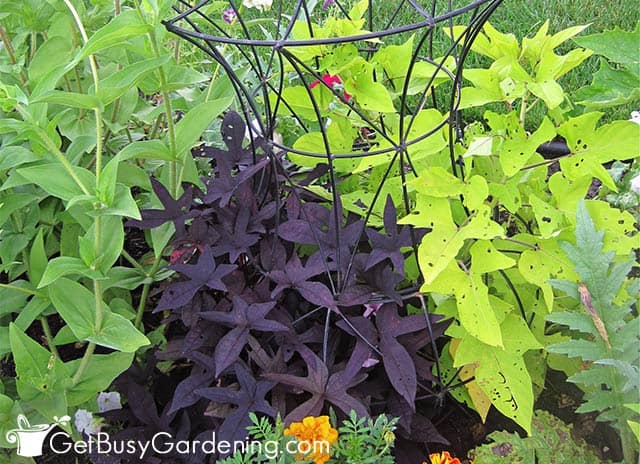
Flowers
Some, but not all varieties of sweet potato vines produce flowers in the right environment.
The trumpet-shaped blooms of ornamental sweet potatoes appear in the late summer or early fall and are often a shade of pink or purple.
Toxicity
According to the ASPCA website, Ipomoea batatas is not toxic, and safe to have around your cats, dogs, and other animals.
As I mentioned above, the tubers are technically edible but don’t taste good, so grow this plant purely for its ornamental beauty.
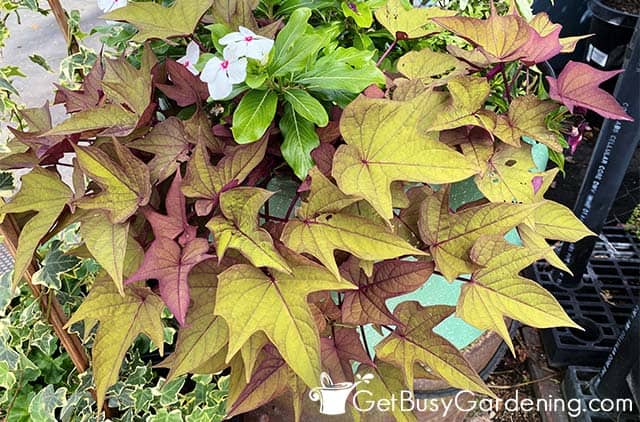
How To Grow Sweet Potato Vine
Before we chat about how to care for sweet potato vine plants, let’s talk about where to grow them.
A good location can make care easy and stress-free, whether you’re putting them in hanging baskets or letting them trail across a flowerbed.
Hardiness
Sweet potato vines are not cold hardy and will die if exposed to temperatures below 45°F (7°C) for extended periods.
These ornamental vines are perennials in zones 9-11, though they will lose their foliage when it drops below about 55°F (13°C). In cooler climates, they’re grown as annuals or overwintered indoors.
Where To Grow Sweet Potato Vines
Sweet potato vine plants are tolerant of a variety of conditions, and will grow quickly in full sun to partial shade.
They can trail or you can train them to climb, and they make excellent ground cover that requires little attention to flourish.
The draping quality of sweet potato vines also makes them popular as filler for containers or for hanging baskets.
They need moist soil, good drainage, warmth, bright light, and humidity to thrive.
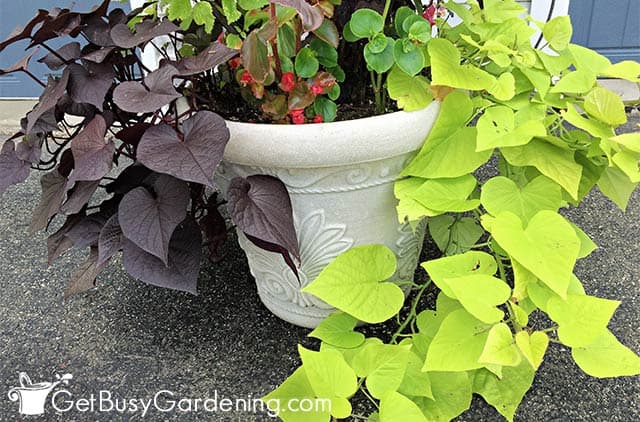
Sweet Potato Vine Care & Growing Instructions
Now that you know the perfect place to grow Ipomoea batatas, it’s time to talk about how to care for them. Use these tips to keep your sweet potato vines thriving and vibrant.
Light
Sweet potato vines need 6 or more hours of light per day. They prefer the morning sun over the harsher afternoon rays, but some varieties, such as the ‘Marguerite’ and ‘Ragtime’ cultivars, can thrive in full sun.
The foliage colors will be less intense in dimmer light. If you’re growing it indoors, you may need a plant light to supplement the natural sun and boost color intensity.
Water
Sweet potato vine plants are drought tolerant, but prefer consistently moist soil. They don’t like wet feet, though, and overwatering will lead to root and tuber rot.
Water when the top 1” of soil feels dry, but never to the point of making it soggy. Always drain all the excess water from containerized plants.
A moisture gauge, like this one is a great tool that can help you maintain the ideal level more easily.
Humidity
Sweet potato vines don’t like to dry out, and prefer humid environments. Keep the soil evenly moist and add wood or straw mulch to help maintain the levels outside.
Indoors, place a humidifier nearby or position the plant on a pebble tray.

Temperature
The ideal temperature range is between 50 and 95°F (10 and 35°C). The foliage will begin to die back if it gets below 45°F (7°C).
Exposure to freezing temperatures for too long will cause the sweet potato vine tubers to die as well.
Highs of 100°F (37°C) are tolerable, but your sweet potato vines will need more frequent watering, and may experience slower growth at these temperatures.
Fertilizer
Sweet potato vines have naturally vigorous growth, so fertilizer is not required as part of their regular care.
However some gardeners like to give them a jumpstart at the beginning of the growing season.
Add general purpose slow-release granules during planting or in early spring, and that is all they’ll need.
Soil
Ornamental sweet potatoes are tolerant of many different types of soil, but they prefer a rich, well drained mixture with a pH between 6 and 7.8.
Use a good quality general-purpose mix for containers, or make your own outdoor potting soil using my recipe.
Transplanting & Repotting
Most people grow ornamental sweet potato vines as annuals, so they won’t require repotting.
Sweet potato vine bulbs that are dormant and properly stored can be transplanted into the garden when warmer weather returns.
But if yours lives in the same container for several years, you will eventually need to repot it.
Wait until spring when it’s above 50°F (10°C), then move them up 1-2 pot sizes. Water thoroughly and keep them somewhere bright and warm while they recover.
Pruning
You can consistently prune your sweet potato vine plants throughout the season to encourage bushier growth, control the size, and prevent legginess.
Use sharp and sterile pruners to trim away any dead or damaged leaves throughout the year. Make cuts ¼” above the leaf nodes to promote branching growth.
To create a bushier plant instead of vine-like tendrils, prune it regularly from spring through fall.
Pest Control Tips
Aphids, whiteflies, weevils, caterpillars, and beetles, such as the sweet potato looper, golden tortoise beetle, cucumber beetle, and flea beetles, are among the most common sweet potato vine insect pests.
But they’re also prone to attack from squirrels, moles, and gophers, which like to feed on the tubers.
Picking larger insects off by hand and dropping them in soapy water is the most effective natural pest control method.
For smaller bugs, use neem oil spray or an organic insecticidal soap. I make my own by combining 1 teaspoon of gentle liquid soap and 1 liter of water.
Physical barriers like metal fencing and hardware mesh are helpful deterrents for animal pests.
Dormancy
When exposed to cold temperatures, sweet potato vines enter a dormant state. Once this happens, cut off the dead foliage and dig up the tubers.
Store the dormant tubers in a suitable container in a sheltered location for the winter, and do not let them freeze.
See my guide for more information on how to overwinter sweet potato vines for success every time.
Propagation Tips
Propagating a sweet potato vine is easy to do via division or by taking cuttings in the spring, summer, or fall.
It’s a common way for cold-climate gardeners to keep their favorite varieties year after year.
Use sharp, sterile pruners to clip long, healthy stems. Then remove all but the topmost leaves to expose the nodes.
Dip them in rooting hormone powder and plant them in soil, or submerge the nodes in water and wait for them to root. Then sit back and watch your sweet potato vine grow.
You can get more specific step by step instructions for propagating your sweet potato vine here.

Troubleshooting Common Problems
Sweet potato vines are easy to care for and quick to grow. But, like any plant, they sometimes suffer from poor health. Use these tips to get your vines back in good condition.
Leaves Turning Yellow
The most common causes of yellow or brown leaves on sweet potato vines are improper watering or poor light conditions.
They like evenly moist soil and will start to yellow if they dry out completely, or if you overwater to the point where they develop root rot.
Move them to a location with partial shade if they’re exposed to too much direct afternoon sun.
And, if they’re in pots or hanging baskets, make sure the container has holes in the bottom to allow the excess water to drain away.
Sweet Potato Vines Dying
Root rot, disease, pests, and cold temperatures are all common causes for dying sweet potato vines.
Treat pests immediately to prevent severe damage, and use a moisture gauge to ensure proper hydration.
It’s also a good idea to remove dead and dry leaves, which will help keep the plant healthy and looking nice.
They also need to be kept above 55°F (13°C). If your climate is too cold, overwinter the plants indoors in a warmer location, or take cuttings and root them for the following spring.
Drooping / Wilting Leaves
Drooping leaves are likely caused by improper watering, high heat, or transplant shock.
Both too much or too little water can cause the leaves of sweet potato vines to wilt.
Intense sun during hot weather can also cause wilting, especially if the plant is underwatered. This is a particular danger in warmer climates
Sweet Potato Vines Not Growing
Drought, temperature, and lack of light could all be slowing or stalling growth for your sweet potato vines.
Keep the well draining soil evenly moist and try to maintain a temperature between 55 and 95°F (13 and 35°C).
Keep these vigorous vines in partial sun for 6 or more hours a day to encourage faster growth. You can also top-dress with fertilizer granules to invigorate them.
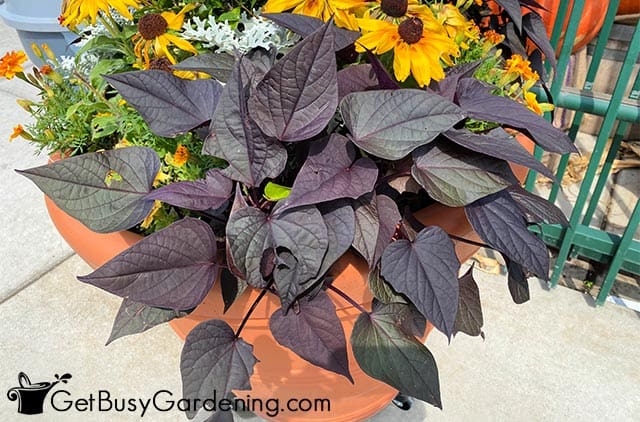
FAQs
Here I’ve answered some of the most commonly asked questions about sweet potato vine care. If yours isn’t on the list, please add it to the comments section below.
Is sweet potato vine annual or perennial?
A sweet potato vine is technically a perennial, but only in warmer climates (zones 9-11). It’s not cold hardy and is commonly grown as an annual in cooler regions.
Can you eat the tubers from ornamental sweet potatoes?
Technically you can eat the tubers from ornamental sweet potatoes. But they’re bitter and don’t taste good, so they’re best grown for purely decorative purposes.
Do sweet potato vines grow sweet potatoes?
Sweet potato vines do not grow the sweet potatoes that we’re familiar with from the grocery store. They do form edible tubers, but they don’t taste good, so I don’t recommend eating them.
Is sweet potato vine easy to grow?
Yes, sweet potato vines are easy to grow because they don’t require any special care. They’re tolerant of many different soil types, sun exposures, and don’t need fertilizer to be prolific.
Does sweet potato vine come back every year?
In zones 9-11 sweet potato vines can come back every year, as long as the ground doesn’t freeze. The foliage will die back when it gets below 45°F (7°C), but the tuber will survive and grow again in the spring.
If you want to learn all there is to know about maintaining healthy indoor plants, then you need my Houseplant Care eBook. It will show you everything you need to know about how to keep every plant in your home thriving. Download your copy now!
More About Flower Gardening
- How To Care For Coleus Plants
- How To Care For Dahlias
- How To Care For Angel Wing Begonia
- How To Care For Caladiums
- Annual Flower Bed Designs For Beginners
- 17 Best Ground Cover Plants That Grow Well In The Shade
Share your ornamental sweet potato vine care tips in the comments section below.




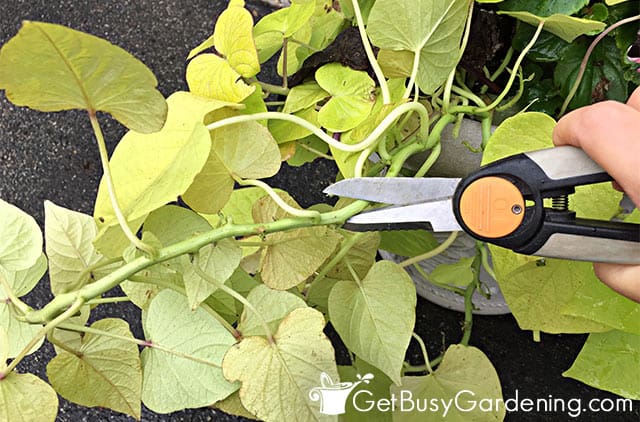


Cruse Teresa A. says
I have always started sweet potato vines in the spring by soaking the bulb in water, it sprouts, I pluck the sprout and add it to a glass of water to develop roots, then plant.
How do I get colored leaves?
Amy Andrychowicz says
Awesome! You have to buy to ones with the colored leaves, they are a different variety of sweet potato vine. Look for them at your local garden center in the spring.
Tony Smo says
The tubers I harvest at end of summer are purple in color, quite large and taste delicious. I purchase from a nursery and don’t pay attention to what variety they are. Beautiful plant & vegtable !
Amy Andrychowicz says
Sounds like you found yourself a great variety of sweet potato, yum!